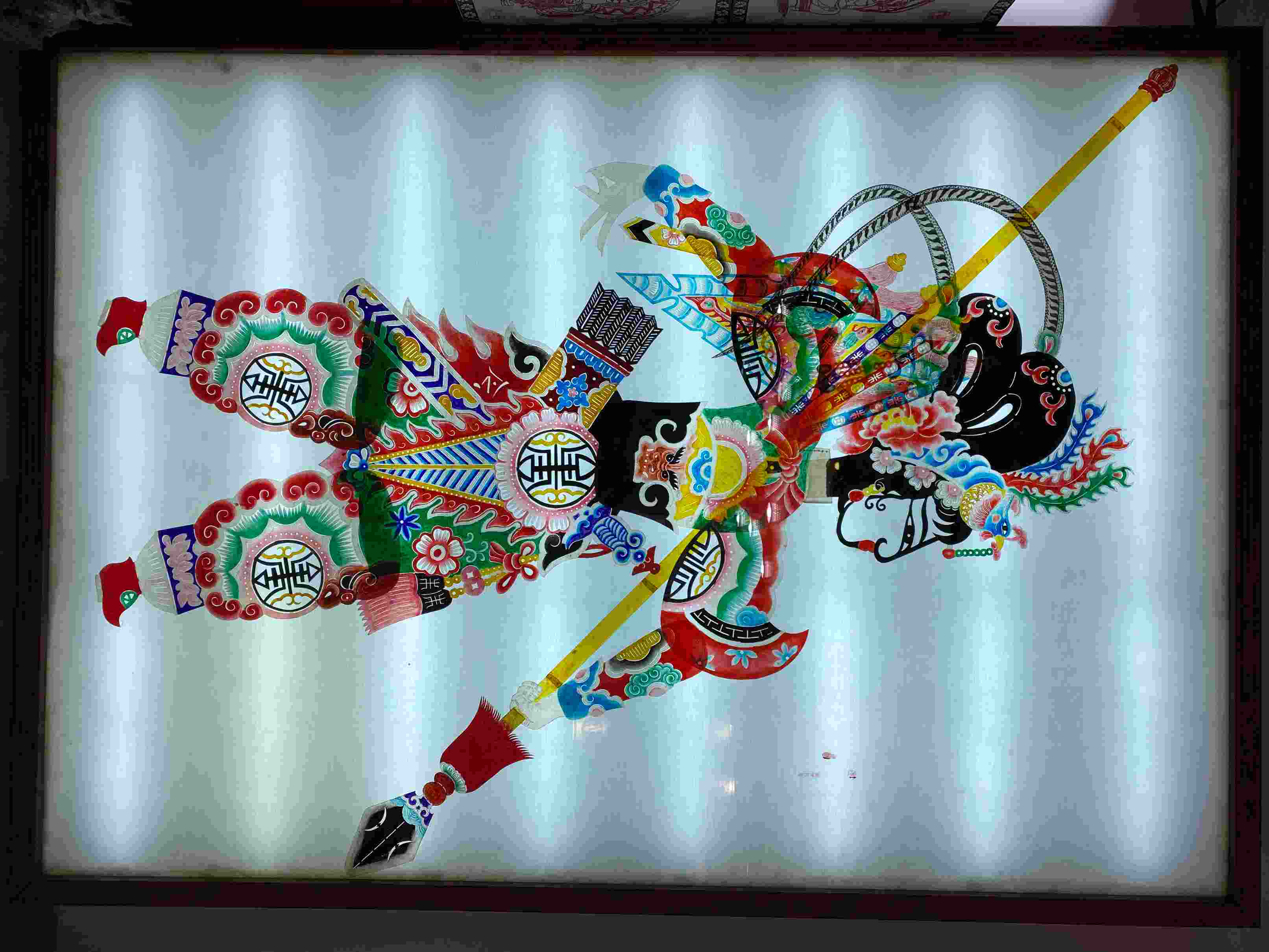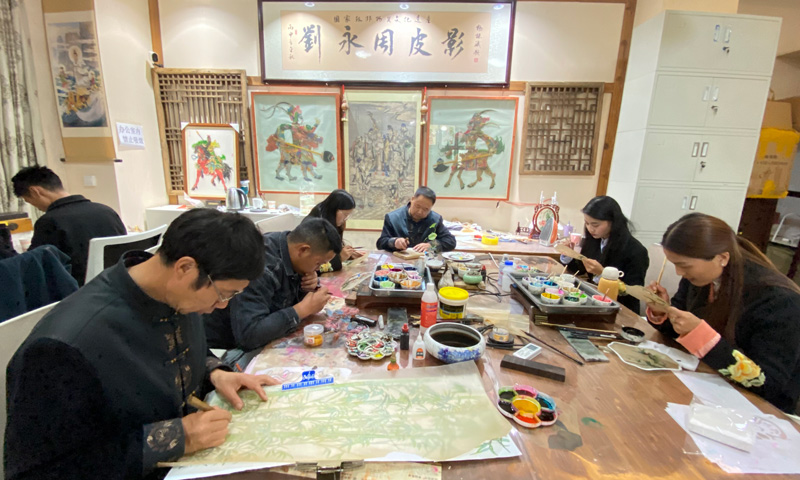


A shadow puppet portraying Hua Mulan, a fictional folk heroine in ancient China, at a shadow puppetry theater in Tengchong, Yunnan Province. (People's Daily Online/Meng Bin)
Sleeping in the showcase, a shadow puppet may look like nothing special. Without a good look, one probably couldn't tell it from the paper-cuttings commonly seen in art galleries. Just hold on. A nocturnal creature, the puppet usually comes out after sunset; only in the hands of a puppeteer will it wake up and begin its daily stretches.
When the light source and music are ready, the puppets, controlled by rods, will step onto the "stage," a translucent cloth screen illuminated from behind, and the show is on.
Rigid as they may look, the puppets turn out to be very lively and pliable. Sitting, running and dancing, these are just a snap, with bowing, fighting, or even laughing gaining a big round of applause. The real talent of a puppet is that it can move and change so swiftly that the audiences can capture its silhouette flashing on the screen, a unique feature that can't be seen in either comic books or animated films.

A puppeteer is manipulating a puppet with rods. (People's Daily Online/Meng Bin)
With its distinctive features, shadow puppetry (also known as shadow play), an ancient form of storytelling that originated in China more than 2,000 years ago, still enjoys its popularity today.
Behind the scenes
During the performance, the puppets are the absolute protagonist, but behind the scenes, it is those laborious hands, both on and off the stage, that bring the puppets to life.
A shadow puppet is usually carved out of cattle or donkey hide, materials that are durable and rot-proof. A skillful carver may need up to 30 knives and chisels to finish the carving of one puppet, which can last for weeks, but carving and painting are merely half the work.
To make a puppet move, its body parts (head, limbs, and torso, etc.) need to be separated before reconnected by thread and links. The number of moveable joints will determine the flexibility of the puppet.

Inside a studio of a shadow puppetry theater, artists are carving, painting and coloring the puppets. (People's Daily Online/Meng Bin)
While audiences are shouting bravo for the dazzling performance, puppeteers behind the curtain need to concentrate. A minor mistake could have a ripple effect and ruin the entire show.
Staging a shadow puppetry show is a team effort and a textbook example of multitasking. Manipulating the puppets into moving and posturing within a second is fairly hard. It's even harder to synchronize the action of the puppets with the singing, instruments, and other sound effects, while making sure every aspect of the show, such as lighting and transition, run smoothly. Usually, the room on the stage is limited, so one puppeteer may control two or three puppets while simultaneously controlling the switch of the light source.
Puppeteer stays, puppetry saved
Just like so many species on our planet earth that are in danger of extinction, traditional arts also face the risk of disappearance, and shadow puppetry isn't immune.
"Many young people still hold the impression that shadow puppetry is some kind of old-fashioned folk art…one that appears in obsolete sacrificial activities," said Liu Chaokan, who is the sixth-generation inheritor of shadow puppetry in Liujiazhai, Tengchong County, southwest China's Yunnan Province.
Some would rather watch easy-to-understand clips on their pixel screens, an instant joy that prevails in modern society, than try to comprehend or appreciate traditional arts. "People may ask why would I bother watching this while there are (so many) movies and TV shows to consume," said Liu.
Before deciding to carry the torch of Liujiazhai shadow puppetry that his family had operated for more than two centuries, Liu Chaokan was practicing shooting as a student-athlete in college. Not only did his major have nothing to do with shadow puppetry, but some of his college friends also cast their doubts about the future of the family business. They couldn’t understand why he would choose to work on an "old and unattractive" art that had few audiences. "A friend once asked me that, young people didn't even have the patience to watch films and TV series, so why would they watch this puppetry show?"
Empty seats and discouraging comments didn't deter him. It was his enthusiasm for shadow puppetry and the ambition to let the old art continue to shine in modern life that made him decide to stay on.

Liu Chaokan (Right) and his family members in a group photo inside their old house in Liujiazhai, Tengchong, Yunnan. (People's Daily Online/Meng Bin)
Shadow puppetry is lucky enough to have a young guardian like Liu Chaokan, who, though only 28 years old, has thrown all of his energy into the love of his life. It is the continuous efforts, generation after generation, that has prevented the old art from falling into oblivion. The puppeteer stays, and the puppetry is saved.
Old art, young blood
A young guy himself, Liu Chaokan understands why some old art forms couldn't appeal to the young, which is why he has decided to combine fresh content and brand-new stories with the traditional form of storytelling.
Inside his shadow puppetry theater in Tengchong, puppets of Chinese household heroes and heroines, including Monkey King, Guan Yu and Hua Mulan are displayed at the most prominent places. Liu has invested a huge amount of time and hired many college graduates to readapt and remake those old folk stories. By adding new elements into old stories, he hopes his shows can attract the young generation.
In a recent show adapted by his team based on the ancient Chinese novel "Journey to the West," Baigujing (or White Bone Spirit), a demon from the novel, dances to the Korean pop hit Gangnam Style.
Boonie Bears, Ne Zha, and Pleasant Goat, favorite Chinese cartoon characters, together with their foreign counterparts, are Liu’s secret in engaging the attention of children, who he believes are the building blocks of the art's future. "Since they couldn't understand those old stories, why don't we show them the cartoon characters they love in the shadow puppetry show?" said Liu, "With interests, they are willing to know what the puppets are made from and how to make them, which sows the seed of the art."
Short video sharing platforms like Tik Tok have also been Liu's new tool to disseminate shadow puppetry. A short clip of the show can easily get thousands of likes on the platform, and many of his followers have come all the way to his theater to enjoy a piece of authentic shadow puppetry live performance.
To keep the old art forever young, Liu believes puppeteers should also respect its traditions. "You can't shake the roots of the art, like using paper or plastic to fabricate a shoddy puppet for example," Liu said, adding, "Preserving its traditions and seeking innovation are equally important."

 Award-winning photos show poverty reduction achievements in NE China's Jilin province
Award-winning photos show poverty reduction achievements in NE China's Jilin province People dance to greet advent of New Year in Ameiqituo Town, Guizhou
People dance to greet advent of New Year in Ameiqituo Town, Guizhou Fire brigade in Shanghai holds group wedding
Fire brigade in Shanghai holds group wedding Tourists enjoy ice sculptures in Datan Town, north China
Tourists enjoy ice sculptures in Datan Town, north China Sunset scenery of Dayan Pagoda in Xi'an
Sunset scenery of Dayan Pagoda in Xi'an Tourists have fun at scenic spot in Nanlong Town, NW China
Tourists have fun at scenic spot in Nanlong Town, NW China Harbin attracts tourists by making best use of ice in winter
Harbin attracts tourists by making best use of ice in winter In pics: FIS Alpine Ski Women's World Cup Slalom
In pics: FIS Alpine Ski Women's World Cup Slalom Black-necked cranes rest at reservoir in Lhunzhub County, Lhasa
Black-necked cranes rest at reservoir in Lhunzhub County, Lhasa China's FAST telescope will be available to foreign scientists in April
China's FAST telescope will be available to foreign scientists in April